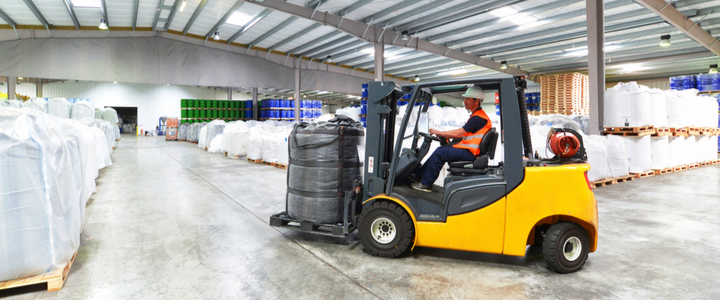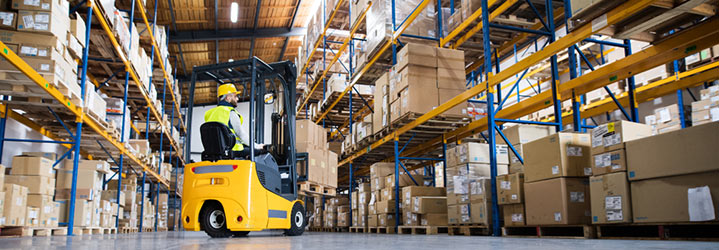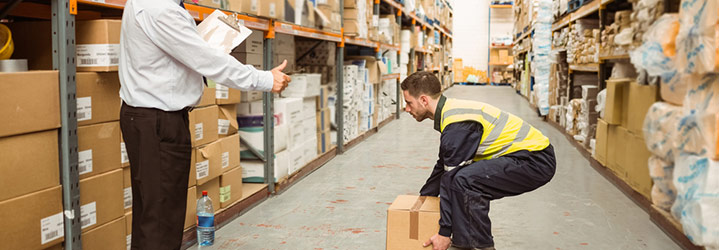Preventing accidents in the warehouse requires a proactive approach and a commitment to safety from everyone involved. By implementing proper safety measures, warehouses can create a better work environment for all employees.
Common Warehouse Safety Hazards (& How to Prevent Them)
In any warehouse environment, there are countless hazards that pose risks to workers. By identifying these dangers and implementing preventive measures, warehouse managers can significantly reduce the likelihood of accidents. Let’s explore some of the most prevalent warehouse safety hazards and strategies for preventing them:
- Slips, Trips, and Falls
- Hazard: Wet or slippery floors, cluttered aisles, and uneven surfaces can lead to slips, trips, and falls.
- Prevention: Keep floors clean and dry, use non-slip mats, ensure clear walkways and aisles, and promptly clean up spills. Provide proper footwear with slip-resistant soles and encourage employees to wear them at all times.
- Forklift Accidents
- Hazard: Forklifts are essential for moving heavy loads in the warehouse but can pose serious risks if not operated properly.
- Prevention: Provide OSHA forklift safety and training to operators, enforce speed limits and safe driving practices, and establish designated pedestrian walkways separated from forklift traffic. Conduct regular maintenance checks on forklifts to ensure they are in good working condition.

- Falling Objects
- Hazard: Overloaded or improperly stacked shelves can lead to falling objects, posing a risk to workers below.
- Prevention: Train employees on proper stacking and shelving techniques, use safety nets or barriers to catch falling objects, and conduct regular inspections of storage racks to ensure they are secure and stable.
- Manual Handling Injuries
- Hazard: Lifting heavy objects manually can result in strains, sprains, and other musculoskeletal injuries.
- Prevention: Provide training on proper lifting techniques, encourage the use of lifting aids such as pallet jacks or hoists for heavy loads, and implement ergonomic workstations to reduce strain on employees’ bodies.
- Chemical Exposure
- Hazard: Warehouses may store hazardous chemicals that can pose health risks if not handled properly.
- Prevention: Ensure proper labeling and storage of hazardous chemicals, provide employees with appropriate personal protective equipment (PPE) such as gloves and goggles, and train workers on the safe handling and disposal of chemicals.
Strategies for Protecting Warehouse Workers
OSHA is committed to guaranteeing safe and healthy working environments for workers across the nation, which includes approximately 1.6 million individuals employed in nearly 20,000 warehouses nationwide.

As workplace safety experts, we know what it takes to create a safe environment for all warehouse workers. Let’s explore some key strategies to minimize risks and ensure a safer workplace for everyone.
1. Implement Proper Training Programs
First and foremost, warehouse safety training programs are essential for warehouse safety. Ensure that all employees complete training on equipment operation, safe lifting techniques, hazard recognition, and emergency procedures. Ongoing training and refresher courses should also be provided to keep employees up-to-date with the latest safety protocols.
2. Maintain Clear and Organized Work Areas
A cluttered and disorganized warehouse is a breeding ground for accidents. Teach employees to keep work areas clean and tidy by implementing regular housekeeping practices. Clearly marked aisles, storage locations, and emergency exits can help prevent trips, slips, and falls. Additionally, maintain clear visibility by ensuring adequate lighting throughout the warehouse.
3. Invest in Proper Material Handling Equipment
Investing in high-quality material handling equipment can significantly reduce the risk of accidents. Ensure that all equipment, including forklifts, pallet jacks, and conveyor systems, is properly maintained and inspected regularly. Provide employees with the appropriate PPE and enforce its use when operating machinery.
4. Promote Ergonomic Practices
Warehouse work often involves repetitive tasks and heavy lifting, which can lead to musculoskeletal injuries. Promote ergonomic practices by providing ergonomic tools and equipment, such as adjustable workstations and lifting aids. Encourage employees to take regular breaks and practice proper lifting techniques to avoid strains and injuries.

5. Conduct Regular Safety Inspections
Regular safety inspections are necessary for identifying hazards and addressing them promptly. Schedule routine inspections of equipment, storage racks, and warehouse facilities to ensure health and safety compliance. Encourage employees to report safety concerns or hazards they encounter during their work shifts.
6. Foster a Culture of Safety
Creating a culture of safety is essential for maintaining a safe workplace environment. Encourage open communication between management and employees regarding safety issues and encourage active participation in safety awareness programs. Recognize and reward employees who demonstrate safe behaviors and actively contribute to maintaining a safe workplace.
Mitigating Warehouse Safety Risks with Safety By Design
At Safety By Design, we’re dedicated to helping organizations prioritize workplace safety. Contact us today to learn more about our Houston safety training programs and consulting services. Together, we can create safer workplaces and prevent accidents in the warehouse.



